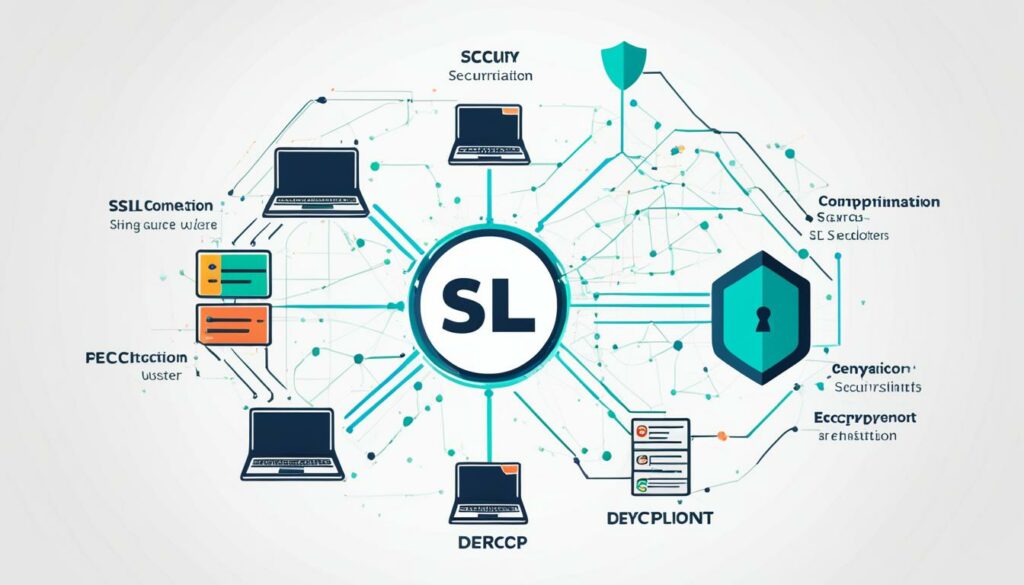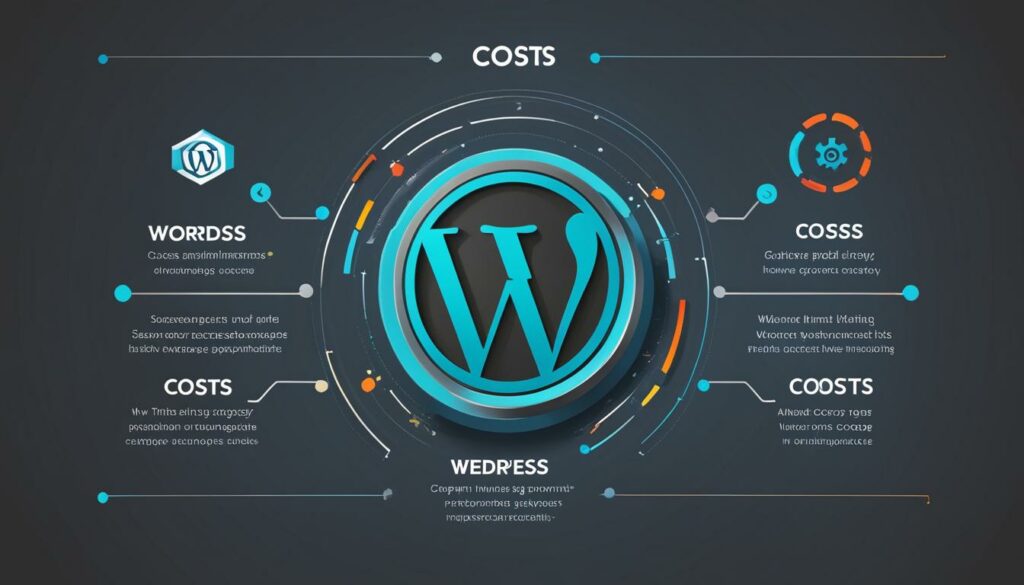Welcome to our comprehensive guide on server optimization for hosting! In today’s digital world, server performance plays a crucial role in ensuring the success of your online presence. Whether you are running a website, an e-commerce store, or a web application, optimizing your servers is essential to boost performance and enhance website speed. In this guide, we will delve into various strategies and techniques that can help you optimize your servers and deliver an exceptional user experience.
Key Takeaways:
- Server optimization is vital for improving performance and website speed.
- Scalability allows you to accommodate growing user bases and handle spikes in traffic.
- Load balancing distributes traffic evenly across multiple servers, ensuring high availability.
- Caching and content delivery mechanisms can significantly boost performance and reduce latency.
- Database optimization enhances server speed by cleaning up data and optimizing queries.
Understanding Server Scalability
In today’s digital landscape, having a scalable server infrastructure is crucial for accommodating the growing needs of your user base and handling traffic spikes effectively. In this section, we will explore the concept of server scalability and discuss the two primary methods: vertical scaling and horizontal scaling.
Vertical Scaling
Vertical scaling, also known as scaling up, involves adding more resources to a single server to handle increased demand. This can include upgrading the server’s hardware components such as the CPU, RAM, or storage capacity. By vertically scaling your server, you can improve its performance and capacity.
However, vertical scaling has limitations. There is a maximum capacity that a single server can handle, and once you reach that point, further upgrades may not be feasible or cost-effective. Additionally, a single server can become a single point of failure, meaning that if it goes down, your entire application or website will be unavailable.
Horizontal Scaling
Horizontal scaling, also known as scaling out, involves adding more servers to your infrastructure to distribute the workload. By spreading the load across multiple servers, you can handle increased traffic and improve overall performance and reliability.
Horizontal scaling offers several advantages. Firstly, it allows for better fault tolerance and high availability. If one server fails, the others can continue to serve requests, ensuring uninterrupted service. Secondly, it provides greater capacity for handling traffic spikes as multiple servers can collectively handle a larger load. Lastly, horizontal scaling can be more cost-effective compared to vertical scaling, as you can start with a smaller number of servers and add more as needed.
Capacity and Resources
When scaling your server infrastructure, it’s important to consider the capacity and resources required to meet your specific needs. Capacity refers to the maximum workload that your servers can handle, while resources refer to the hardware components, network bandwidth, and storage available to your servers.
Assessing your capacity and resources involves understanding your current and future requirements. Factors such as the number of concurrent users, the complexity of your application or website, and the amount of data being processed will influence the necessary capacity and resources.
It’s crucial to strike a balance between capacity and resources to ensure optimal server performance and cost efficiency. Over-provisioning can result in wasted resources and unnecessary expenses, while under-provisioning can lead to performance issues and service disruptions.
To determine the right capacity and resources for your server scalability needs, consider consulting with a knowledgeable professional or a trusted hosting provider. They can help assess your requirements and recommend the most suitable scaling strategy.
Now that you have a good understanding of server scalability, let’s explore load balancing in the next section.
| Vertical Scaling | Horizontal Scaling |
|---|---|
| Allows for quick, single-server upgrades | Improved fault tolerance and high availability |
| Usually requires downtime during server upgrades | Can handle larger traffic spikes by adding more servers |
| Higher cost per server upgrade | Flexible and scalable as per demand |
| Increased risk of a single point of failure | Potentially lower cost compared to vertical scaling |
Load Balancing
Load balancing is a critical strategy for optimizing server performance and ensuring a seamless user experience. By evenly distributing incoming traffic across multiple servers, load balancing prevents any single server from becoming overloaded, thus maintaining high availability and reliability.
Implementing load balancing has several advantages. Firstly, it helps distribute traffic efficiently, preventing bottlenecks and ensuring that each server handles a fair share of requests. This ensures that your website can handle increased traffic without compromising performance.
Load balancing also plays a crucial role in achieving high availability. By distributing workloads across multiple servers, load balancing ensures that if one server fails or experiences issues, others can take on the load, preventing downtime and keeping your website up and running.
Moreover, load balancing enhances reliability by reducing the risk of service disruptions. With a balanced distribution of traffic, the chances of one server being overwhelmed or experiencing hardware failures are significantly reduced. This ensures a reliable and uninterrupted user experience.
To implement load balancing, you can use various approaches such as round-robin DNS, hardware load balancers, or software load balancers. Each method offers its own benefits and can be tailored to your specific needs and infrastructure.
“Implementing load balancing allows you to optimize server performance, distribute traffic efficiently, and ensure high availability and reliability for your website.”
By incorporating load balancing into your server infrastructure, you can effectively optimize performance and deliver a seamless user experience. The following table provides a comparison of different load balancing methods:
| Load Balancing Method | Advantages | Disadvantages |
|---|---|---|
| Round-robin DNS | – Simplicity and cost-effectiveness – Easy to implement and configure – Automatic failover |
– Lack of session persistence – Limited control over traffic distribution – Potential for uneven load distribution |
| Hardware Load Balancers | – Powerful and scalable – Advanced traffic management features – High performance and throughput |
– Expensive upfront cost – Configuration and maintenance complexity – Single point of failure |
| Software Load Balancers | – Flexibility and customization options – Lower upfront cost – Easy integration with existing infrastructure |
– Performance impact on the host server – Limited scalability for high traffic loads – Requires advanced configuration |
“Choosing the right load balancing method depends on your specific needs and infrastructure. Consider factors like scalability, cost, and control over traffic distribution to make an informed decision.”
When implemented effectively, load balancing can significantly enhance the performance, high availability, and reliability of your server infrastructure. It plays a crucial role in optimizing the user experience and ensuring seamless operation even during peak traffic periods.

Caching and Content Delivery
Implementing effective caching and content delivery strategies can greatly boost your website’s performance, allowing it to load faster and reduce latency. By optimizing caching mechanisms and leveraging content delivery networks (CDNs), you can significantly enhance the speed and responsiveness of your website.
The Power of Caching
Caching is a method that stores frequently accessed data closer to the user, reducing the need for resource-intensive queries to the server. By caching static files, images, and pre-rendered content, your website can deliver these elements to users more quickly, resulting in faster load times and an improved user experience.
“Caching is like having a shortcut to information. Instead of going all the way to the server, the information is readily available, boosting performance and reducing latency.”
When a visitor returns to your website, their browser can retrieve the cached data without sending multiple requests to the server. This not only saves server resources but also reduces the time required to fetch and render the content. Caching is particularly effective for websites with dynamic content that doesn’t change frequently.
Content Delivery Networks (CDNs)
Content delivery networks (CDNs) are distributed networks of servers located in various geographic locations. These servers store copies of your website’s files and deliver them to users based on their location. By serving content from a server that is physically closer to the user, CDNs reduce latency and minimize the time it takes for data to travel between the user and the server.
CDNs work by automatically routing users to the nearest server in their network, ensuring that content is delivered quickly and efficiently. By reducing the physical distance between the user and the server, CDNs can significantly improve the speed and performance of your website.
Implementing both caching mechanisms and leveraging CDNs can have a powerful impact on your website’s performance, boosting speed, reducing latency, and enhancing the overall user experience.

Comparing Caching and CDNs
| Aspect | Caching | Content Delivery Networks (CDNs) |
|---|---|---|
| Function | Stores frequently accessed data closer to the user, reducing the need for queries to the server | Serves content from servers located nearer to the user, reducing latency |
| Key Benefit | Reduces server load and speeds up content retrieval | Minimizes latency and delivers content quickly |
| Implementation | Configuring caching mechanisms on the server | Integrating with a CDN provider and configuring DNS settings |
| Best Use | Ideal for static or infrequently changing content | Highly effective for dynamic websites and global audiences |
Database Optimization
When it comes to server performance, optimizing your database is crucial. By cleaning up unnecessary data, indexing tables, and ensuring efficient queries, you can significantly impact server speed and overall performance.
To start, clean up your data by removing any redundant or outdated information. This not only reduces the size of your database but also improves query execution time. Deleting unnecessary data frees up valuable resources and streamlines database operations.
Next, consider indexing tables to enhance query performance. Indexes provide a roadmap for the database engine to quickly locate specific data, similar to using an index in a book. By creating well-designed indexes on frequently accessed columns, you can speed up query execution and improve overall database efficiency.
In addition to cleaning up data and indexing tables, it’s essential to ensure efficient queries. This involves optimizing your SQL statements, using proper join conditions, avoiding unnecessary data retrieval, and minimizing the use of subqueries. Writing efficient queries helps reduce the strain on your server and improves response times.
A well-optimized database plays a vital role in server performance and can greatly enhance the user experience. By implementing these database optimization strategies, you can maximize your server’s potential and achieve optimal website performance.
| Advantages of Database Optimization: | Challenges of Database Optimization: |
|---|---|
|
|
Monitoring and Scaling Tools
Regularly monitoring your server’s performance is essential for identifying and addressing potential issues. To ensure your server runs smoothly, consider utilizing server monitoring tools such as Nagios, Zabbix, or Prometheus. These tools provide valuable insights into your server’s health, allowing you to detect and troubleshoot performance issues promptly.
Nagios: Nagios is a popular open-source server monitoring solution that offers comprehensive monitoring capabilities. It enables you to monitor various aspects of your server, including CPU usage, memory utilization, disk space, and network traffic. With its alerting system, Nagios can notify you in real-time about any potential issues, ensuring that you can address them promptly.
Zabbix: Zabbix is another powerful open-source server monitoring tool that provides a wide range of monitoring functionalities. It offers real-time monitoring of server health, network performance, and application processes. Zabbix allows you to create customized monitoring templates, define threshold values, and receive alerts via email or SMS when issues arise.
Prometheus: Prometheus is a popular cloud-native monitoring system that provides a robust solution for monitoring server performance. It collects and stores time-series data about your server’s metrics, and offers a flexible querying language to analyze and visualize the data. Prometheus also integrates seamlessly with other tools in the cloud-native ecosystem, making it a preferred choice for scalable server monitoring.
“Regular monitoring of your server’s health is crucial in ensuring optimal performance and availability. Utilizing monitoring tools like Nagios, Zabbix, or Prometheus can help you proactively identify and resolve potential issues, maintaining a healthy server environment.”
Scaling Tools
Scaling tools can simplify the process of expanding your server infrastructure to meet growing demands. One popular scaling tool is Kubernetes, an open-source container orchestration platform.
Kubernetes enables you to manage and automate the deployment, scaling, and management of containerized applications across clusters of servers. With its robust features and flexible architecture, Kubernetes can help you dynamically scale your server resources based on workload demands.
By using Kubernetes, you can easily add or remove server instances, ensuring that your application can handle increased traffic and maintain optimal performance. This scalability feature allows you to efficiently allocate server resources and eliminate potential bottlenecks, resulting in a seamless user experience.
When combined with server monitoring tools, scaling tools like Kubernetes offer a comprehensive solution for managing server health and performance in a dynamic environment.
Example Table: Server Monitoring and Scaling Tool Comparison
| Tool | Key Features | Supported Platforms | Price (for basic version) |
|---|---|---|---|
| Nagios | Comprehensive server monitoring, real-time alerts, customizable dashboards | Linux, Windows, Unix | Free (Community Edition), Paid (Enterprise Edition) |
| Zabbix | Real-time monitoring, customizable templates, threshold-based alerts | Linux, Windows, Unix | Free (Community Edition), Paid (Enterprise Edition) |
| Prometheus | Time-series data collection, flexible querying language, seamless integration | Linux, Windows, Mac | Free (Open-source) |
| Kubernetes | Container orchestration, automatic scaling, resource management | Cloud platforms, on-premises servers | Free (Open-source) |
Table: A comparison of server monitoring and scaling tools
To determine the most suitable tool for your specific needs, consider factors such as supported platforms, pricing options, and the features that align with your server monitoring and scaling requirements.

Conclusion
Server optimization is the key to unlocking exceptional performance and a seamless user experience. By implementing various strategies such as server scalability, load balancing, caching and content delivery, database optimization, and utilizing monitoring and scaling tools, you can ensure that your servers operate at their peak potential.
Maximizing server performance is an ongoing process that requires continuous attention and fine-tuning. By understanding the fundamental principles of server optimization, you can optimize your website’s performance, improve loading times, and enhance the overall user experience.
Remember, server optimization is not only about boosting performance but also about prioritizing the user experience. When your website delivers fast load times and seamless navigation, it creates a positive impression on your visitors, increasing user engagement and improving conversion rates.
Investing time and effort into server optimization is well worth it. By optimizing your servers, you ensure that your website operates efficiently, providing visitors with an optimal experience. So, take the necessary steps to optimize your servers, and watch as your website’s performance and user satisfaction soar to new heights.
FAQ
Q: Why is server performance important for a website?
A: Server performance is crucial for a successful digital presence. It determines the speed and responsiveness of your website, directly impacting the user experience.
Q: What is server scalability?
A: Server scalability is the ability of a server infrastructure to accommodate growing user bases and spikes in traffic. It can be achieved through vertical scaling (adding more resources to a single server) or horizontal scaling (adding more servers to distribute the load).
Q: How does load balancing optimize server performance?
A: Load balancing evenly distributes incoming traffic across multiple servers, ensuring that no single server is overloaded. This improves high availability, reliability, and overall performance.
Q: What are caching and content delivery strategies?
A: Caching mechanisms store frequently accessed data, reducing the need for resource-intensive queries. Content delivery networks (CDNs) serve content from servers closer to the user’s location, reducing latency and speeding up content delivery.
Q: How does database optimization impact server performance?
A: Database optimization involves cleaning up unnecessary data, indexing tables for improved query performance, and ensuring efficient queries. These optimizations directly impact server speed and overall performance.
Q: Why is monitoring server performance important?
A: Regularly monitoring server performance allows you to identify and address potential issues before they affect the user experience. Tools like Nagios, Zabbix, or Prometheus provide insights into server health and can alert you to any performance issues.
Q: What are some scaling tools for server infrastructure?
A: Scaling tools like Kubernetes make it easier to expand your server infrastructure as needed. These tools enable seamless scaling and help you meet increasing demands without compromising performance.
Source Links
- https://www.bodhost.com/blog/understanding-server-hosting-a-comprehensive-guide-to-server-host-services/
- https://www.redswitches.com/blog/what-is-server-hosting/
- https://www.linkedin.com/pulse/maximizing-performance-comprehensive-guide-server-scaling-vishnu-r?trk=article-ssr-frontend-pulse_more-articles_related-content-card












